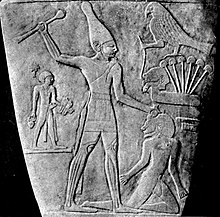Wash (pharaoh)

| ||
| wˁš in hieroglyphs | ||
|---|---|---|
Wash was possibly a pharaoh from the
Background
Wash's historical existence is uncertain. The siltstone object on which he appears was discovered by
If Wash was a historical figure he may have been the last ruler of a Lower Egyptian dynasty based at Buto. Indeed, Narmer's fame rests on being the Upper Egyptian pharaoh to defeat the last Lower Egyptian pharaoh. However, rather than recording this historical event the palette may simply depict an allegory for Narmer's excellence and right of command, with the figure of Wash having been recruited to the task.[8]
Archaeologist Edwin van den Brink argued that another predynastic Lower Egyptian ruler, Hedju Hor, is the figure depicted as Wash. van den Brink based this argument on the similarities between Hor's own heraldic crest, his serekh, and the carving above Wash on the Narmer palette depicting Horus leading a ship out of papyrus reeds with a rope through the nose of its male figurehead.[9]
References
- ^ Egypt,” Encyclopædia Britannica (11th ed.), v. 9, 1911, plate II (between pp. 64 and 65),#23.
- ^ [1] J. E. Quibell, Hierakonpolis pt. I. Plates of discoveries in 1898 by J. E. Quibell, with notes by W. M. F. Petrie, Quaritch, 1900
- ^ [2] J. E. Quibell, Hierakonpolis pt. II. Plates of discoveries, 1898–99, with Description of the site in detail, by F. W. Green., Quaritch, 1902
- ^ The Ancient Egypt Site – The Narmer Palette Archived 2006-06-15 at the Wayback Machine accessed September 19, 2007
- ISBN 978-1885923-82-0., p.148
- ^ a b Heagy, Thomas C. (2014). "Who was Menes?". Archeo-Nil. 24: 59–92., p.66
- ^
Helck, Wolfgang (1987). Untersuchungen zur Thinitenzeit. Ägyptologische Abhandlungen 45. Wiesbaden.
{{cite book}}: CS1 maint: location missing publisher (link), p.98 - ISBN 0-203-20421-2., pp.40–41
- ISBN 0714109991., p.147
